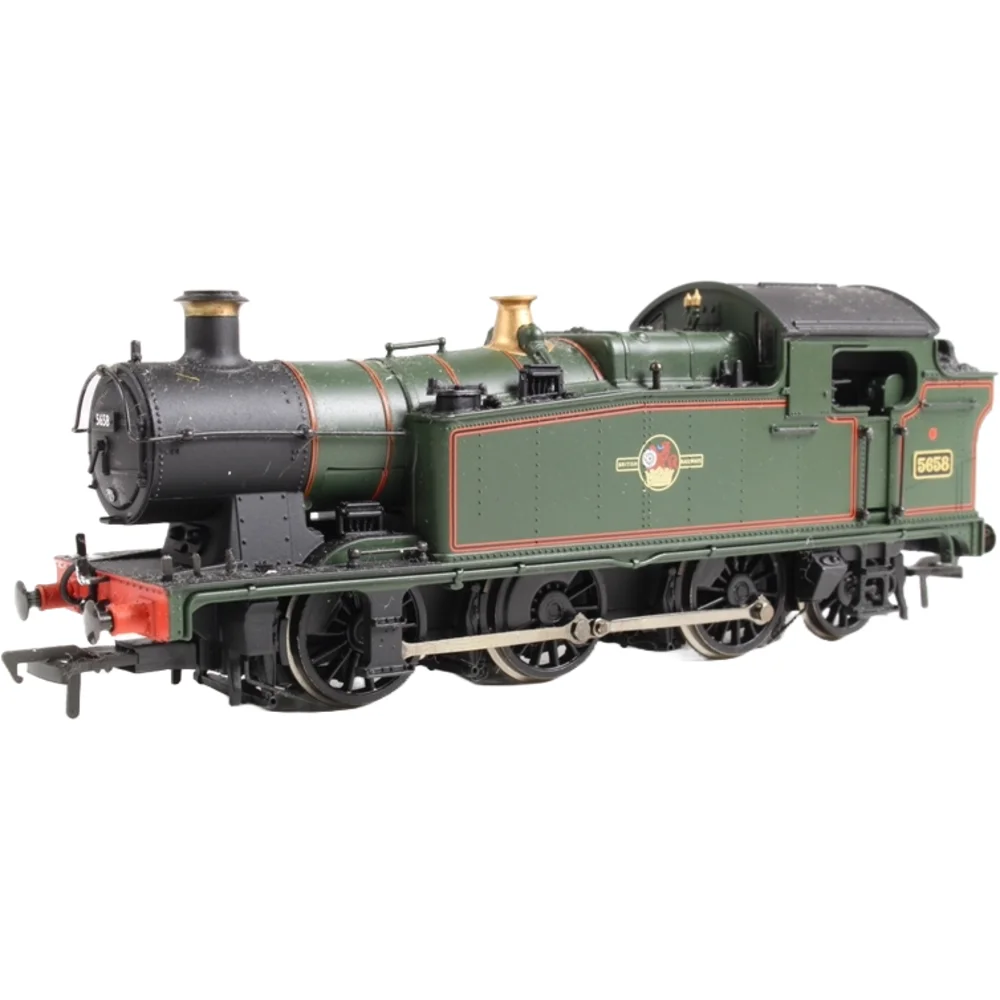Bachmann 32-077
Great Western Railway 5600 5658 British Railways Green with Late Crest
Tooling
In 2002, Bachmann Branchline introduced a completely new tooling for the Great Western Railway (GWR) 5600 Class 0-6-2T tank locomotive. This model replaced the older Mainline version from the 1980s and represented a significant leap forward in accuracy and detail. The prototype, designed by Charles Collett and built between 1924 and 1928, was a rugged South Wales workhorse, ideal for heavy coal trains and sharp curves.
Tooling Features
- Scale: OO Gauge (1:76)
- Construction: Plastic bodyshell with separate detail parts; metal chassis for strength
- Detailing: Factory-fitted handrails, lamp irons, injector pipework, safety valve bonnet, smokebox door dart, water tank caps, whistle, cab glazing, and detailed cab interior
- Couplings: NEM pockets with tension-lock couplers
Mechanical & Electrical
- Motor: 3-pole motor
- Drive: Direct drive to two axles
- Pickup: All wheels
- Minimum Radius: 2nd radius (approx. 438 mm)
- Lighting: None
- Weighting: Internal weighting for adhesion
DCC Capability
DCC compatible but no socket – hardwiring required. This was later addressed in the 2005 upgrade which introduced an 8-pin socket.
Liveries Produced
- GWR Green (pre-nationalisation)
- BR Green with Early Emblem (1948–1957)
- BR Black with Late Crest (1957–1968)
Reviews & Commentary
At launch, the model was praised for its accurate proportions and fine detailing, marking a major improvement over the older Mainline tooling. However, enthusiasts noted the absence of a DCC socket and basic mechanism compared to later Bachmann releases. Social media and forum discussions from the era highlight its popularity among GWR fans, though many upgraded to the 2005 version for digital compatibility.
Interesting Facts
- The 5600 Class was the only 0-6-2T design built new by GWR.
- Prototype locomotives were primarily used in South Wales coal traffic, requiring high tractive effort and strong braking.
- The Bachmann 2002 tooling set a new standard for mid-range OO steam models at the time.
Class & Prototype
- Class: Great Western Railway 5600
- Traction: Steam
- Built: 1924-1928
- Total Built: 200
- Running Number: 5658
Operator & Livery
- Operator: British Railways
- Livery: Green with Late Crest
- Era: 5 - British Railways Late Crest
British Railways transformed Britain's fragmented rail network into a unified national system following nationalisation on 1st January 1948. Created from the "Big Four" companies under the Transport Act 1947, BR operated most of Great Britain's railways until rebranding as British Rail in 1965, managing over 20,000 route miles and inheriting nearly 20,000 locomotives of diverse designs.
The organisation pioneered standardisation through its revolutionary BR Standard locomotive programme (1951-1960), producing 999 advanced steam engines under Robert Riddles' direction. These included the versatile Britannia Pacifics, mighty 9F freight engines, and mixed-traffic classes that incorporated the best features from all predecessor companies. The 1955 Modernisation Plan accelerated diesel and electric traction development, creating fascinating mixed-traction operations.
Notable achievements included establishing unified locomotive classification systems, introducing distinctive corporate liveries, and managing the complex transition from steam to modern traction. BR's six regional structure preserved operational diversity whilst enabling standardisation of practices, signalling, and rolling stock that had eluded private enterprise for over a century.
The BR era represents steam traction's final flowering alongside emerging diesel technology, creating unparalleled locomotive variety. Today, this heritage remains highly popular with railway enthusiasts through extensive preserved fleets, heritage railway operations, and comprehensive model ranges from manufacturers like Hornby, Bachmann, and Dapol, making BR subjects essential for authentic post-war British railway modelling across all scales.
